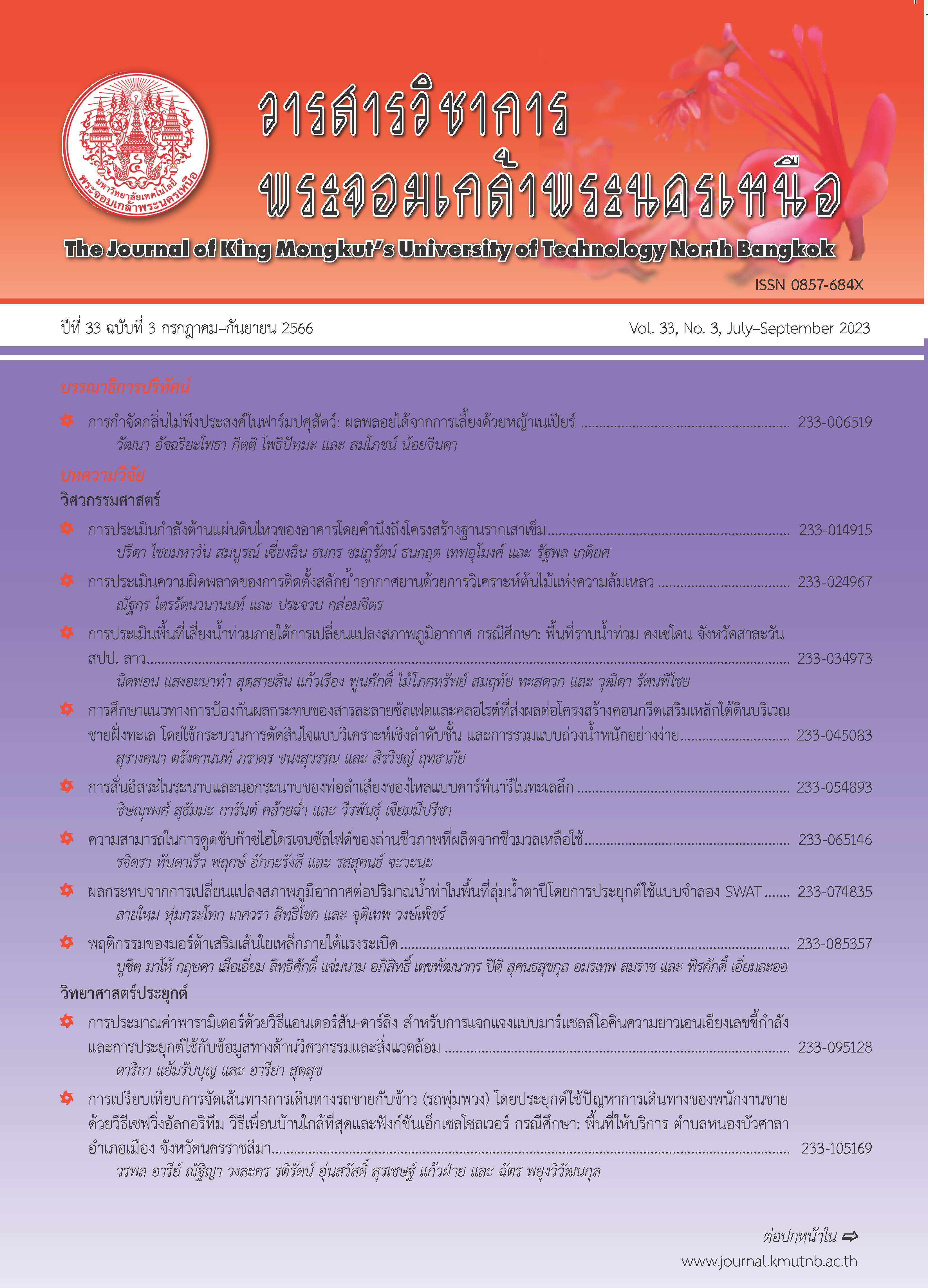พฤติกรรมของมอร์ต้าเสริมเส้นใยเหล็กภายใต้แรงระเบิด
Main Article Content
บทคัดย่อ
ความเสียหายที่เกิดขึ้นจากการก่อการร้ายเป็นสิ่งที่ไม่สามารถคาดการณ์ได้ ในจังหวัดชายแดนใต้ของประเทศไทยได้เกิดความขัดแย้ง และความรุนแรงมาตั้งแต่ พ.ศ. 2547 จนถึงปัจจุบัน ทำให้มีการสูญเสียที่ไม่สามารถประเมินค่าได้ เหตุการณ์ส่วนใหญ่เกิดจากการกราดยิงและใช้วัตถุระเบิดซึ่งทำให้มีผู้บาดเจ็บและเสียชีวิตเป็นจำนวนมากเนื่องจากไม่มีที่กำบังหรือที่หลบภัยที่สามารถป้องกันได้ ดังนั้นโครงสร้างที่สามารถป้องกันกระสุนและระเบิดจึงเป็นสิ่งสำคัญในการป้องกันความเสียหายเหล่านี้ งานวิจัยนี้จึงมีเป้าหมายในการปรับปรุง และเพิ่มประสิทธิภาพในการต้านทานแรงระเบิดของผนังมอร์ต้า โดยใช้เส้นใยเหล็กชนิดปลายงอ ปริมาณร้อยละ 2 โดยปริมาตร เพื่อศึกษาความสามารถและพฤติกรรมในการต้านทานแรงระเบิด จึงทำการทดสอบด้วยระเบิด TNT ขนาด 0.5 ปอนด์ ที่ระยะปรับทอน เท่ากับ 0.55 0.65 และ 0.75 ผลการทดสอบพบว่า มอร์ต้าเสริมเส้นใยเหล็กมีประสิทธิภาพในการต้านทานแรงระเบิดได้ดีกว่ามอร์ต้าธรรมดาในทุกกรณี โดยจากความเสียหายที่เกิดขึ้นนั้นบ่งชี้ว่ามอร์ต้าธรรมดาเกิดการวิบัติที่มีความรุนแรง และเสียหายโดยเกิดเป็นรอยร้าวขนาดใหญ่บริเวณกึ่งกลางผนัง แตกต่างกับมอร์ต้าที่มีเส้นใยเหล็กที่สามารถช่วยกระจายแรงและยึดรั้งรอยแตกร้าวทำให้เกิดความเสียหายลดลงจนกระทั้งแทบไม่เกิดความเสียหายใดๆ อีกทั้งยังมีความสามารถในการรับกำลังหลังจากรับแรงระเบิดได้สูงกว่ามอร์ต้าธรรมดาได้อีกด้วย
Article Details

อนุญาตภายใต้เงื่อนไข Creative Commons Attribution-NonCommercial-NoDerivatives 4.0 International License.
บทความที่ลงตีพิมพ์เป็นข้อคิดเห็นของผู้เขียนเท่านั้น
ผู้เขียนจะต้องเป็นผู้รับผิดชอบต่อผลทางกฎหมายใดๆ ที่อาจเกิดขึ้นจากบทความนั้น
เอกสารอ้างอิง
Deep South Watch (DSW). (2021, July). Deep South Watch. [Online]. (in Thai). Available: https://deepsouthwatch.org
P. Sukontasukkul, S. Mindess, and N. Banthia, “Penetration resistance of hybrid fibre reinforced concrete under low velocity impact loading,” Annual Conference of the Canadian Society for Civil Engineering, Montreal, Quebec, Canada, June 2002.
M. Nili, A. H. Ghorbankhani, A. AlaviNia, and M. Zolfaghari, “Assessing the impact strength of steel fibre-reinforced concrete under quasistatic and high velocity dynamic impacts.” Construction and Building Materials, vol. 107, pp. 264–271, 2016.
X. Xu, T. Ma, and J. Ning, “Failure mechanism of reinforced concrete subjected to projectile,” Engineering Failure Analysis, vol. 96, pp. 468– 483, 2019.
T. Zhan, Z. Wang, and J. Ning, “Failure behaviors of reinforced concrete beams subjected to high impact loading,” Engineering Failure Analysis, vol. 56, pp. 233–243, 2015.
D.Y. Yoo, U. Gohil, T. Gries, and Y.S. Yoon, “Comparative low-velocity impact response of textile-reinforced concrete and steelfiber- reinforced concrete beams,” Journal of Composite Materials, vol. 50, no. 17, pp. 2421–2431, 2016.
N. Banthia, P. Gupta, and C. Yan, “Impact resistance of fiber reinforced wet-mix shotcrete - Part I: beam tests,” Materials Structures, vol. 32, no. 8, pp. 563–570, 1999.
V. Bindiganavile and N. Banthia, “Polymer and steel fiber-reinforced cementitious composites under impact loading–Part 2: Flexural toughness,” ACI Materials Journal, vol. 98, no. 1, pp. 17–24, 2001.
P. Gupta, N. Banthia, and C. Yan, “Fiber reinforced wet-mix shotcrete under impact,” Journal of Materials Civil Engineering, vol. 12, no. 1, pp. 81–90, 2000.
D. Y. Yoo and N. Banthia, “Impact resistance of fiber-reinforced concrete – A review,” Cement and Concrete Composites, vol. 104, 2019.
P. Sukontasukkul S. Jamnam, K. Rodsin, and N. Banthia, “Use of rubberized concrete as a cushion layer in bulletproof fiber reinforced concrete panels,” Construction and Building Materials, vol. 41, pp. 801–811, 2013.
S. Jamnam, B. Maho, A. Techaphatthanakon, Y. Sonoda, D. Y. Yoo, and P. Sukontasukkul, “Steel fiber reinforced concrete panels subjected to impact projectiles with different caliber sizes and muzzle energies,” Case Studies in Construction Materials, vol. 13, 2020.
R. Sovják, T. Vavriník, J. Zatloukal, P. Máca, T. Mičunek, and M. Frydrýn, “Resistance of slim UHPFRC targets to projectile impact using in-service bullets,” International Journal of Impact Engineering, vol. 76, pp. 166–177, 2015.
P. Máca, R. Sovják, and P. Konvalinka, “Mix design of UHPFRC and its response to projectile impact,” International Journal of Impact Engineering, vol. 63, pp. 158–163, 2014
P. Máca, R. Sovják, and T. Vavrˇiník, “Resistance of ultra high performance fibre reinforced concrete to projectile impact,” in Structures Under Shock and Impact XII. UK: WIT Press, 2013, pp. 261–272.
D. Y. Yoo, N. Banthia, S. W. Kim, and Y. S. Yoon, “Response of ultra-high-performance fiberreinforced concrete beams with continuous steel reinforcement subjected to low-velocity impact loading,” Composite Structure, vol. 126, pp. 233–245, 2015.
A. M. Zeyad, “Effect of fibers types on fresh properties and flexural toughness of selfcompacting concrete,” Journal of Materials Research and Technology, vol. 9, no. 3, pp. 4147–4158, 2020.
W. D. Kennedy, Explosions and explosives in air, Washington DC, USA: NDRC, 1946.
PDC-TR 06-01, “Single Degree of Freedom Blast Design Spreadsheet (SBEDS) Methodology. Manual,” U.S. Army Corps of Engineers Protective Design Center Technical Report, 2008.
TM-5-855-1, “Fundamentals of protective design for conventional weapons” Washington DC, USA: Technical Manual, US Department of the Army, 1986.
C. Wu, J. Li, and Y. Su, “Ultra-high performance concrete slabs under blast loads, Development of Ultra-High Performance Concrete Against Blasts From Materials to Structures,” in Woodhead Publishing Series in Civil and Structural Engineering, Woodhead Publishing, 2018, pp. 95–213.
J. Li, C. Wu, and H. Hao, “Investigation of ultra-high performance concrete slab and normal strength concrete slab under contact explosion,” Engineering Structure, vol. 102, pp. 395–408, 2015.
J. Li, C. Wu, H. Hao, Z. Wang, and Y. Su, “Experimental investigation of ultra-high performance concrete slabs under contact explosions,” International Journal of Impact Engineering, vol. 93, pp. 62–75, 2016.
B. Maho, P. Sukontasukkul, S. Jamnam, E. Yamaguchi, K. Fujikake, and N. Banthia, “Effect of rubber insertion on impact behavior of multilayer steel fiber reinforced concrete bulletproof panel,” Construction and Building Materials, vol. 216, pp. 476–484, 2019.
B. Maho, S. Jamnam, P. Sukontasukkul, K. Fujikake, and N. Banthia, “Preliminary study on multilayer bulletproof concrete panel: impact energy absorption and failure pattern of fibre reinforced concrete, Para-rubber and styrofoam sheets,” Procedia Engineering, vol. 210, pp. 369–376, 2017.
C. Wu, D.J. Oehlers, M. Rebentrost, J. Leach, and A.S. Whittaker, “Blast testing of ultra-high performance fibre and FRP-retrofitted concrete slabs,” Engineering Structure, vol. 31, no. 9, pp. 2060–2069, 2009.
D. Y. Yoo, N. Banthia, S. W. Kim, and Y. S. Yoon, “Response of ultra-high-performance fiberreinforced concrete beams with continuous steel reinforcement subjected to low-velocity impact loading,” Composite Structure, vol. 126, pp. 233–245, 2015.
B. M. Luccioni and M. Luege, “Concrete pavement slab under blast loads,” International Journal of Impact Engineering, vol. 32, pp. 1248–1266, 2006.
R. Hajek, M. Foglarand, and A. Kohoutkova “Recent development in blast performance of fiber-reinforced concrete,” Materials Science and Engineering, vol. 246, no. 1, 2017.

